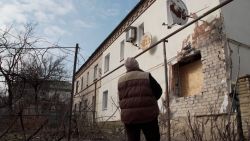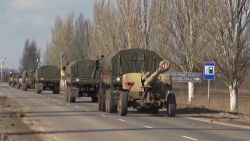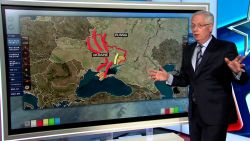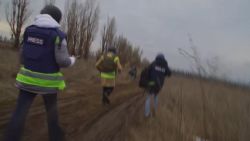Story highlights
Debaltseve, a small town in eastern Ukraine, has been a focus for violence
One Ukrainian soldier leaving the area called it "a one-way street to the grave"
It is a crucial rail hub for rebel-held areas, connecting Luhansk and Donetsk
Fighting has devastated the area and the civilians who are left are living underground
In driving snow and frigid temperatures, one Ukrainian fighter on a tank leaving the besieged town of Debaltseve described it as “a one-way street to the grave.”
The surrounding roads are littered with the wreckage of what were once Ukrainian military positions, an obliterated checkpoint, the remains of people in an armed personnel carrier hit by an explosion.
Inside the once bustling town, the icy, devastated, streets are empty. The few civilians too old or sick to flee cower indoors desperately, hoping not to be killed by the near-constant shelling.
Destruction doesn’t discriminate, and nurseries have been hit by shells as well as City Hall, devastating the city’s infrastructure.
This small transport hub in eastern Ukraine has become a focus for bitter violence between Ukrainian military and pro-Russian separatists following a ceasefire agreement four days ago that has faltered.
Most of Ukraine’s armed forces have been pulled out of the strategic railroad town following weeks of fierce gunbattles and street fights, according to its military, while one rebel leader claimed that separatists had taken over 80% of the town.
Separatists claimed to have 60 Ukrainian prisoners of war, although CNN cannot independently verify those claims.
If you hadn’t heard of Debaltseve before today, it’s not surprising.
It was a small, nondescript Soviet-era town, which had a population of just 25,000 before fighting started.
So why exactly has it become a key focus for violence?
Strategic hub
For one thing, Debaltseve is a vital rail transport hub for the pro-Russian rebels.
It is the site of strategic rail and highway junctions that connect rebel-held strongholds of Donetsk and Luhansk, which is near the Russian border.
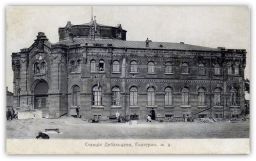
Part of infrastructure built in the Soviet era when Ukraine was part of the Soviet Union, Debaltseve is key for transporting coal, steel and supporting other heavy industries in the region.
Debaltseve’s rail hub is one of three crucial positions – the other two being Donetsk international airport and the industrial port of Mariupol – which, if caught, would be ideal for Russia to open a land corridor to recently annexed Crimea, according to The Jamestown Foundation.
Ceasefire misfire?
Debaltseve, at that time held by Ukrainian forces but encircled by separatists, was not specifically addressed in the ceasefire agreement.
It was always an issue of contention: Separatists believed it was theirs under the recent Minsk agreement.
“The separatists took it as carte blanche that the city was theirs,” reports CNN’s Nick Paton Walsh.
Geographically, it was a little bit of Ukraine-controlled land that stuck up into separatist-controlled areas that they wanted, he said.
“It was always within their territory because they’d encircled it, (the separatists contended),” Paton Walsh said. “Although that’s not the way the West or Kiev perceived it.”
Civilian toll
Fighting in the city – which a spokesman for the Ukrainian government’s military operation, Sladislav Seleznyov, last week described as the most dangerous place in the country – has taken a huge toll on the civilian population.
Only 3,000-4,000 of Debaltseve’s former population of 25,000 remain.
Outside the city, near the village of Ugelgorsk, separatist shells rocked the farmland – fired from an SA13 Gopher Air Defense System, according to experts Jane’s – more evidence of the kind of modern firepower in separatist hands.
Civilians have been caught in the crossfire between artillery coming from rebels on one side and the Ukrainian army on the other – and have literally had nowhere to run.
Many have been trying to find shelter from the violence underground, living in basements.
A local resident, Antonina, bundled against the cold in a red coat and woolen headscarf, wept as she described how her husband Yevgeny was killed in November about a week before he turned 65.
“He said, ‘Run! Get down in the basement.’ But he stayed up here and the shell hit. He lived for a moment, but he died just here. And it tore up everything. How can we live?”
CNN’s Jessica King in Atlanta contributed to this report.



